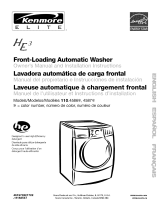
TABLEOF CONTENTS
PROTECTION AGREEMENTS ....................................................... 2
In the U.S.A ................................................................................... 2
In Canada ..................................................................................... 2
WARRANTY ..................................................................................... 3
PEDESTAL OPTION WARRANTY ................................................. 3
WASHER SAFETY ........................................................................... 4
INSTALLATION REQUIREMENTS ................................................ 5
Tools and Parts ............................................................................ 5
Options ......................................................................................... 5
Location Requirements ................................................................ 6
Drain System ................................................................................ 7
Electrical Requirements ................................................................ 8
INSTALLATION INSTRUCTIONS .................................................. 9
Remove Transport System ........................................................... 9
Connect the Inlet Hoses ............................................................... 9
Route the Drain Hose ................................................................ 10
Secure the Drain Hose .............................................................. 10
Level the Washer ....................................................................... 10
Complete Installation ................................................................. 11
FEATURES AND BENEFITS ....................................................... 11
WASHER USE .............................................................................. 12
Starting Your Washer ................................................................ 12
Using the Proper Detergent ...................................................... 12
Using the Dispenser .................................................................. 13
Pausing or Restarting ................................................................ 14
Changing Cycles, Options and Modifiers ................................. 14
Status Lights .............................................................................. 14
Cycles ........................................................................................ 15
Normal Sounds .......................................................................... 16
Options ...................................................................................... 16
Modifiers .................................................................................... 17
Laundry Guide ........................................................................... 17
LAUNDRY TIPS ............................................................................ 18
Loading ...................................................................................... 18
WASHER CARE ........................................................................... 19
Cleaning Your Washer ............................................................... 19
Water Inlet Hoses ...................................................................... 20
Vacation, Storage and Moving Care ......................................... 20
TROUBLESHOOTING .................................................................. 21
SERVICE NUMBERS ............................................... BACK COVER
PROTECTION AGREEMENTS
Master Protection Agreements
Congratulations on making a smart purchase. Your new
Kenmore ®product is designed and manufactured for years of
dependable operation. But like all products, it may require
preventive maintenance or repair from time to time. That's when
having a Master Protection Agreement can save you money and
aggravation.
Purchase a Master Protection Agreement now and protect
yourself from unexpected hassle and expense.
The Master Protection Agreement also helps extend the life of
your new product. Here's what's included in the Agreement:
v' Expert service by our 12,000 professional repair specialists
v' Unlimited service and no charge for parts and labor on all
covered repairs
v' "No-lemon" guarantee - replacement of your covered
product if four or more product failures occur within twelve
months
v' Product replacement if your covered product can't be fixed
v' Annual Preventive Maintenance Check at your request - no
extra charge
v' Fast help by phone - phone support from a Sears technician
on products requiring in-home repair, plus convenient repair
scheduling
v' Power surge protection against electrical damage due to
power fluctuations
v' Rental reimbursement if repair of your covered product takes
longer than promised
Once you purchase the Agreement, a simple phone call is all that
it takes for you to schedule service. You can call anytime day or
night, or schedule a service appointment online.
Sears has over 12,000 professional repair specialists, who have
access to over 4.5 million quality parts and accessories. That's
the kind of professionalism you can count on to help prolong the
life of your new purchase for years to come. Purchase your
Master Protection Agreement today!
Some limitations and exclusions apply. For prices and
additional information, call 1-800-827-6655.
Sears Installation Service
For Sears professional installation of home appliances, garage
door openers, water heaters, and other major home items, in the
U.S.A. call 1-800-4-MY-HOME ®.
n C_: ada
Maintenance Agreements
Your purchase has added value because you can depend on
Sears HomeCentraP for service. With over 2,400 Service
Technicians and more than a million parts and accessories, we
have the tools, parts, knowledge and skills to back our pledge:
We Service What We Sell.
Your Kenmore ®product is designed, manufactured and tested to
provide years of dependable operation. But like all products, it
may require service from time to time. The Sears Maintenance
Agreement offers you an outstanding service program, affordably
priced.

























